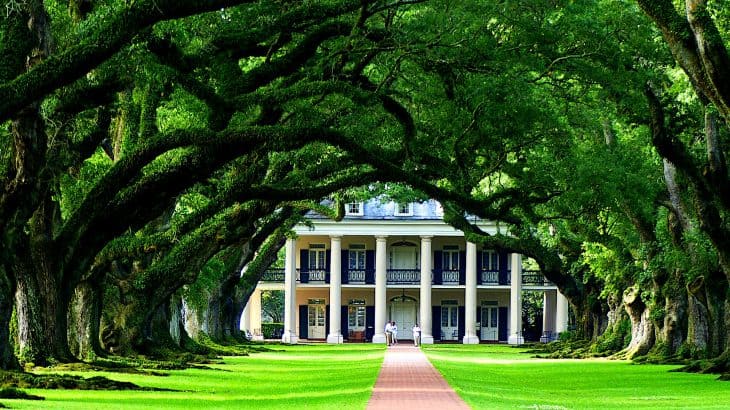
Found in the Deep South of the US is the state of Louisiana. Amidst its sleepy wetlands and marshy bayous, Louisiana holds centuries of heritage in terms of food, culture and music. Also known as The Child of the Mississippi, Louisiana houses the river along its length before it empties into the Gulf of Mexico. However, there’s more to this state than its hearty seafood dishes and blues music. Take yourself to a quiet escape in this little world of Louisiana facts.
- Louisiana covers an area of over 135,000 km².
- An estimated 113,000 km² of Louisiana’s area is land.
- The remaining estimated 21,000 km² of Louisiana’s area is water.
- As of 2019, Louisiana’s population totals 4.65 million residents.
- On average, Louisiana stands 30 meters high above sea level.
- Native Americans first lived in what is now Louisiana as far back as 3700 BC.
- Native Americans built the first burial mounds in Louisiana between 300 BC to 800 AD.
- Native Americans started farming corn in Louisiana in the 13th Century AD.
- Panfilo de Narvaez led the first Europeans to Louisiana in 1528.
- The French began settling Louisiana in the late-17th Century.
- Robert Cavalier de La Salle named the region Louisiana in 1682 to honor King Louis XIV of France.
- Britain, France, and Spain repeatedly fought over Louisiana throughout the 18th Century.
- Napoleon sold Louisiana to the United States in 1803 for the price of 60 million Francs.
- Louisiana was the 18th State to join the Union on April 30, 1812.
- Louisiana joined the Confederacy during the US Civil War.
- Baton Rouge hails as Louisiana’s capital, found along the east bank of the Mississippi River.
- New Orleans is Louisiana’s biggest city, lying along the Mississippi River Delta.
- Louisiana is the only US state to have parishes instead of counties as local government units.
- Louisiana has had the highest homicide rate in the USA since the 1990s.
- As of 2018, Louisiana is the least healthy state in the USA, with high rates of alcoholism and drug-related deaths.
Louisiana Facts Infographics
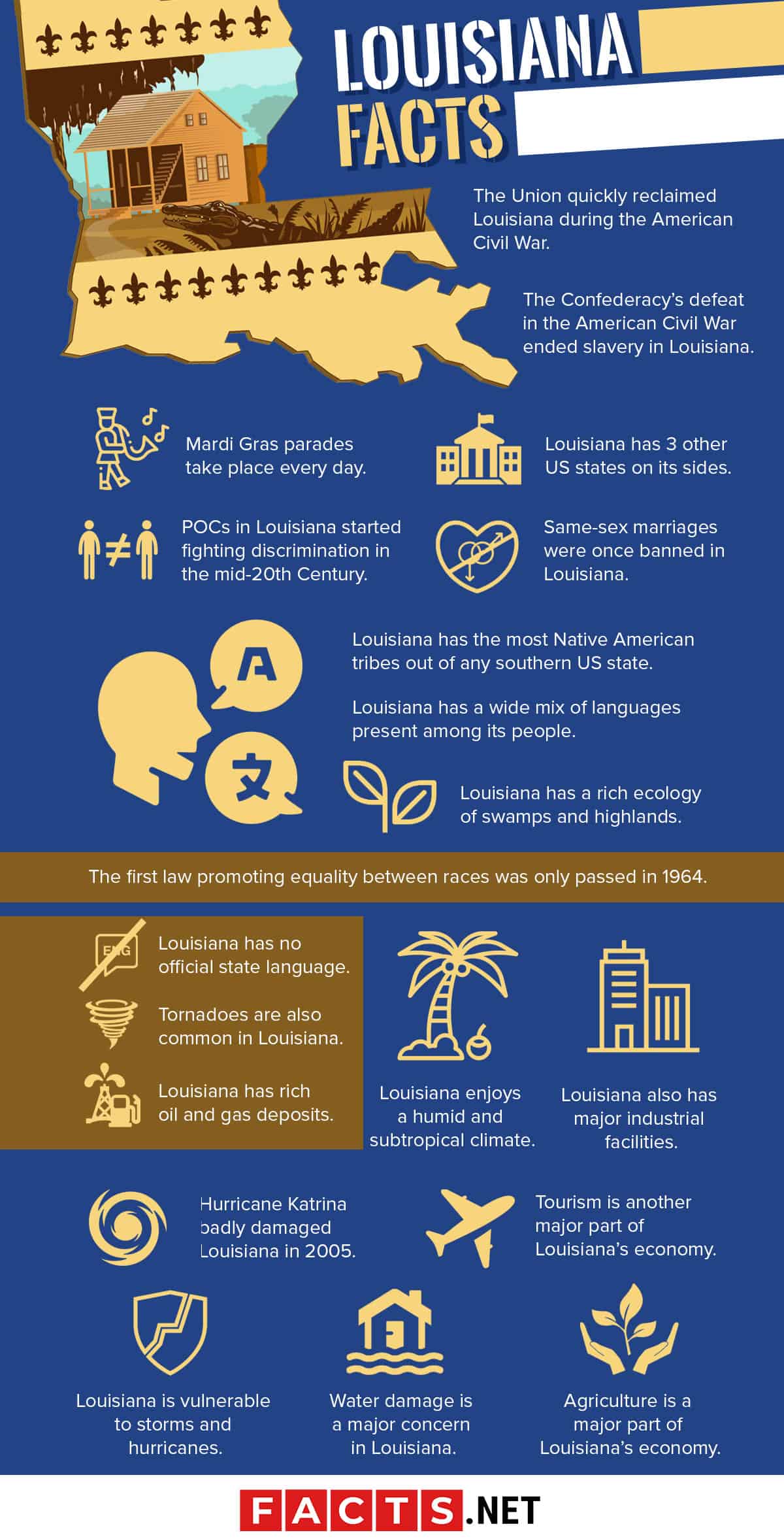
The Union quickly reclaimed Louisiana during the American Civil War.
During the American Civil war, the Union prioritized reclaiming Louisiana because of two factors. One was its position along the lower part of the Mississippi River, and the other is New Orleans’ status as a major port central to business and other transactions.
Retaking the state would limit the Confederacy’s ability to access the seas and trade with other nations, and so reduce their access to foreign resources and trade profits. The Union’s Mississippi campaign concluded in victory on April 25, 1862, only barely a year after the civil war’s beginning on April 12, 1861.
The Confederacy’s defeat in the American Civil War ended slavery in Louisiana.
At the time, over 300,000 people in Louisiana were slaves, making up 47% of the population of around 700,000. Despite the extension of citizenship and voting rights to former slaves, the white community in Louisiana aimed to limit black and other person of colors’ rights.
As a result, POCs had to adhere to different regulations for poll taxes, residency requirements, and even literacy tests. Definitely one of the Louisiana Facts to remember.
Large numbers of Blacks and other people of color left Louisiana in the early-20th Century.
Historians refer to this event as the Great Migration, starting in 1916 and lasting until the 1970s. Throughout this period, blacks and other ethnic minorities fled Louisiana and other predominantly-white southern states for the north. In doing so, they hoped to escape discrimination and find better jobs.
At the peak of WWII, many traveled west to California, where jobs opened up in defense industries to support the war effort in the Pacific.
POCs in Louisiana started fighting discrimination in the mid-20th Century.
The mid-20th century marked a period of activism not just in Louisiana, but across the whole of the southern US states. In Louisiana, veterans of WWII and the Korean War formed self-defense groups against White supremacist groups like the Ku Klux Klan. However, most of these movements supported nonviolent means to push for equal treatment in law and society.
The first law promoting equality between races was only passed in 1964.
It took centuries of discrimination before the first legislation for POCs was successfully passed in the form of the Civil Rights Act of 1964. Even then, there remained plenty of opposition, requiring the federal government to order state police units to enforce the law and protect POC leaders and civil rights activists from reprisals.
Same-sex marriages were once banned in Louisiana.
That came to an end in 2015, when the US Supreme Court declared the ban unconstitutional. Ever since then, same-sex marriages across the whole state have steadily increased.
Louisiana has 3 other US states on its sides.
Louisiana lies beside Texas to the west, Arkansas to the north, and Mississippi to the east. The only direction Louisiana faces that isn’t occupied by another state is the south. Instead, the south of Louisiana faces the Gulf of Mexico.
Louisiana has a rich ecology of swamps and highlands.
The wetlands of Louisiana hold many native species like ibis and egrets, as well as numerous kinds of tree frogs. Fishes native to Louisiana include sturgeons and paddlefish. For Louisiana’s native plant life, Longleaf pine dominates the forests of its highlands, along with many kinds of orchids and carnivorous plants.
Louisiana has the most Native American tribes out of any southern US state.
The state of Louisiana houses the most Native American tribes in the US, with the Chitimacha, the Coushatta, the Choctaw, and the Tunica-Beloxi federally recognized. Additionally, ten tribes in Louisiana holds recognition from the state government, such as the Adai Caddo, the Biloxi-Chitimacha, and the Bayou Lafourche among others.
Finally, Louisiana also houses tribes unrecognized by neither the federal or state governments. Some of these unofficial tribes include the United Houma, the Talimali, the Atakapa Ishak, and the Chahta. Now that’s one for Louisiana facts that show its rich heritage.
Louisiana has a wide mix of languages present among its people.
Historically, Louisiana had been occupied by countries of different rule, namely the British, the French, and the Spaniards fighting over Louisiana in the past. The vast number of slaves regularly arriving in the state before the Civil War also contributed to the state’s diverse dialects.
Languages used across Louisiana include English, French, Spanish, Haitian, African, and even Native American. Talk about diverse Louisiana Facts.
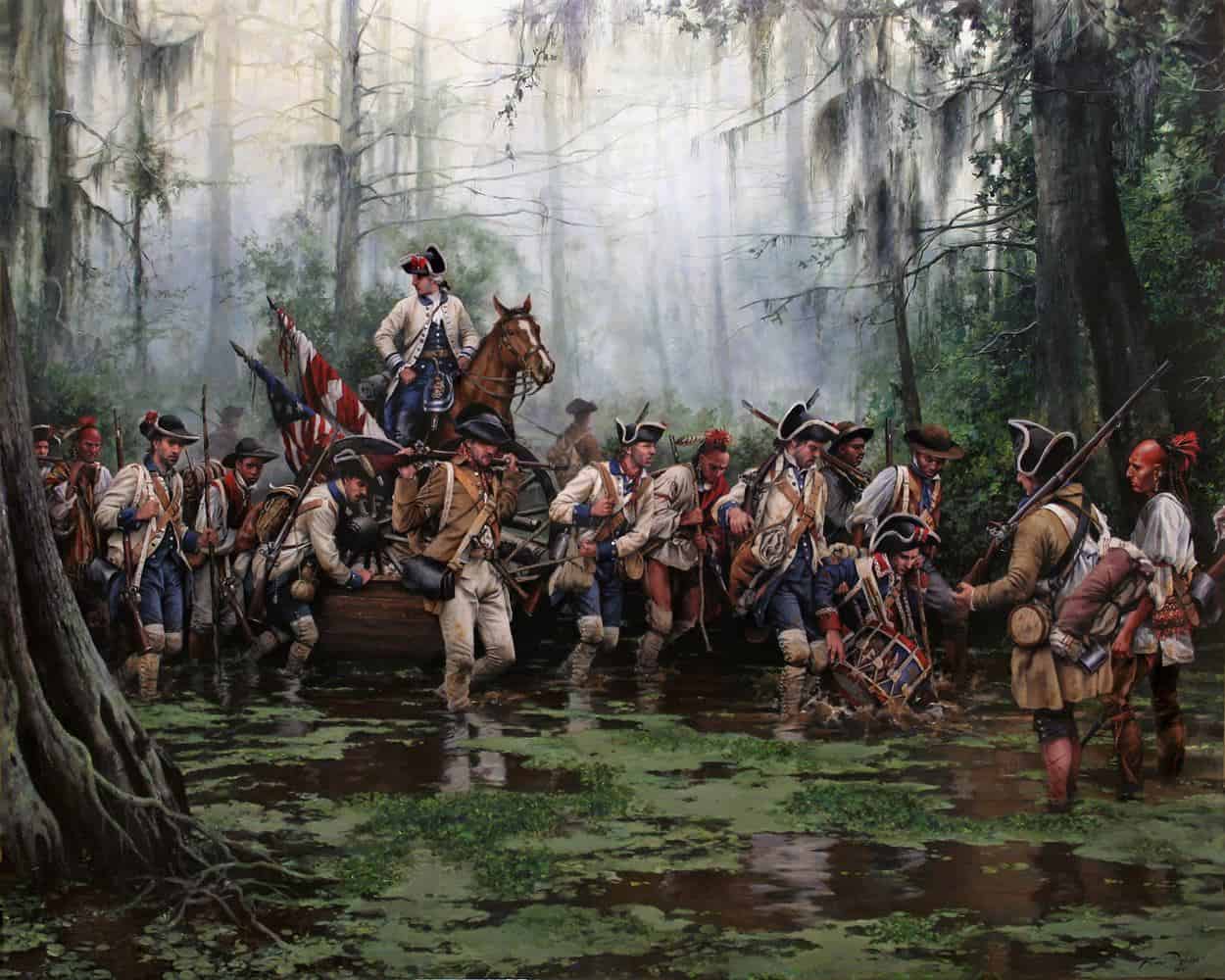
Louisiana has no official state language.
Despite the large mix of languages spoken by its residents, Louisiana doesn’t have a state language. That said, an attempt was previously made to establish English as the official language. In 1921, English became the sole language used in education, but the rule has since been abandoned in 1974. From there up to now, Louisiana has taken pride in its multilingual culture.
Louisiana enjoys a humid and subtropical climate.
The Louisiana climate is characterized by long, hot, and humid summers, along with short winters. Rain is common throughout the whole year, though it generally gets more frequent as winter approaches.
On average, summer temperatures range from 22°C to 32°C. In winter, temperatures average from 8°C down to 3°C.
Louisiana is vulnerable to storms and hurricanes.
This is an unfortunate consequence of the state’s geography. Specifically, Louisiana’s location along the coast of North America on the Gulf of Mexico places it on the path of storms and hurricanes moving north into the continent from the gulf. On average, Louisiana endures at least 60 days’ worth of storms and hurricanes each year.
Tornadoes are also common in Louisiana.
About 27 tornadoes strike Louisiana on average in a single year. They’re also more common in the north than in the south, though that’s no guarantee of complete safety for people living in Southern Louisiana. A dangerously-windy example of Louisiana Facts, no matter how we look at it.
Water damage is a major concern in Louisiana.
During the rainy season, the wide and deep Mississippi tends to overflow its banks, flooding the surrounding land. Storm surges along the Gulf of Mexico are also not unknown in Louisiana.
As a result, the state installed levees and canals to help control the flow of water, and reinforce riverbanks when they overflow. However, flash floods and storm surges still endanger Louisiana despite these efforts.
Hurricane Katrina badly damaged Louisiana in 2005.
In its wake, Hurricane Katrina gravely damaged New Orleans, with an estimated 80% of the city submerged by the time the storm was through. The hurricane left 1500 casualties in Louisiana alone, with over 2 million more across the state.
The insufficient preparation for the storm, as well as the slow response from the government led to massive criticism in Katrina’s aftermath. Definitely one of the more unfortunate Louisiana facts.
Kisatchie National Forest is one of the biggest nature reserves in Louisiana.
This nature reserve covers an area of land over 2,400 km², with a flatwood forest covering over half of that land. Many rare plant and animal species thrive in the forest, such as the Louisiana pine snake and red-cockaded woodpecker among others.
Agriculture is a major part of Louisiana’s economy.
Agricultural products exported by Louisiana include cotton, soybeans, sugarcane, and even rice. Aside from cattle, poultry, and eggs, Louisiana is the biggest producer of crawfish in the whole world.
Louisiana also has major industrial facilities.
Chemical, oil, and coal products are also among Louisiana’s major exports, along with paper and processed foods. Louisiana also manufactures heavy machinery such as transport equipment.
Louisiana has rich oil and gas deposits.
Not counting the offshore fields in the Gulf of Mexico, Louisiana holds 2% of the USA’s total oil reserves, and 5% of the USA’s total gas reserves. Oil and gas have actually been the foundation of the state economy since the 1940s.
This sizable amount of oil and gas reserves have been disputed by the state and federal governments since the 1950s.
Tourism is another major part of Louisiana’s economy.
Tourists come to see Louisiana’s rich cultural legacy, born of the state’s history and the varied peoples that live there. In fact, tourism earns Louisiana over $5 billion per year alone.
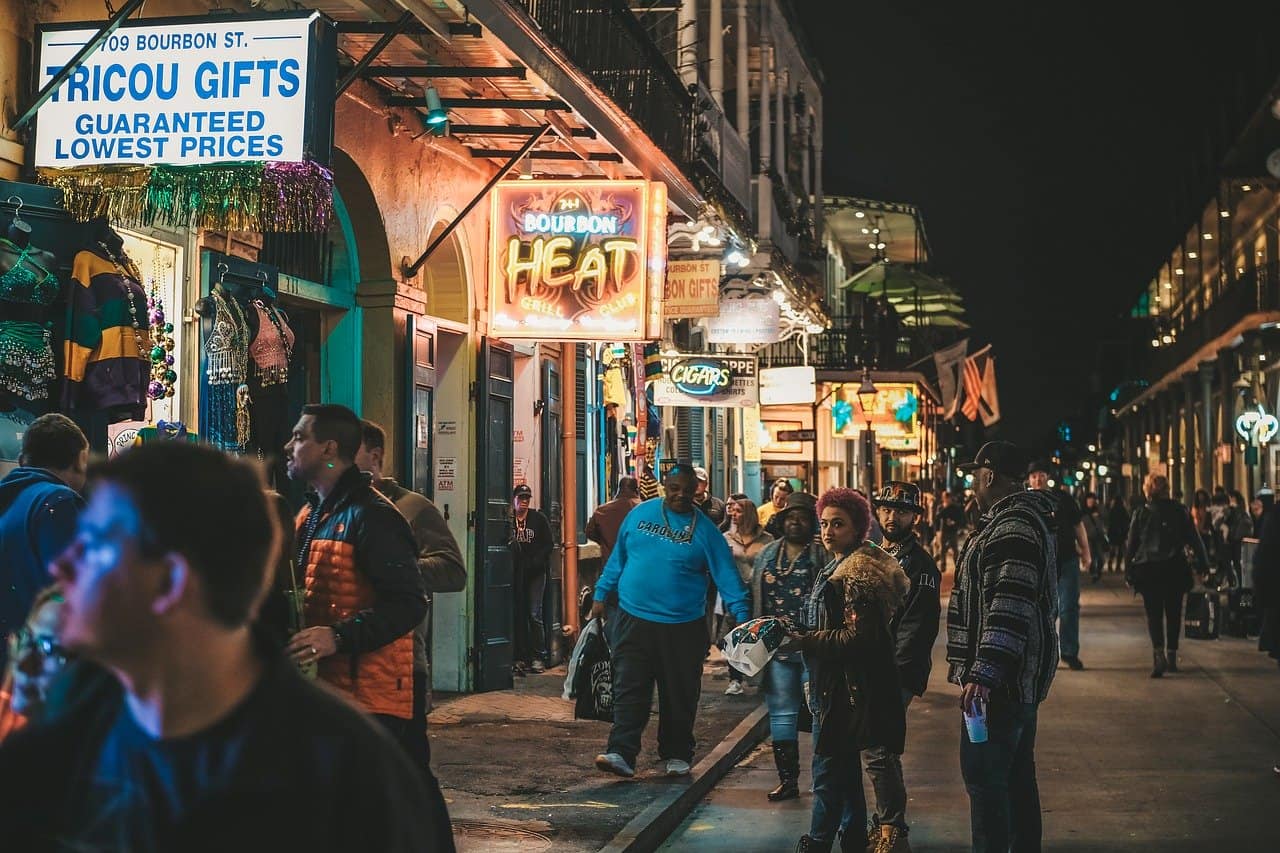
Louisiana is the birthplace of jazz.
To be exact, jazz was born in New Orleans in Louisiana. Marked with strong rhythms and improvised syncopation, brass bands and piano players pioneered jazz music in the late-19th and early-20th Centuries.
In the decades since, jazz spread around the world, acting as an unofficial ambassador for Louisiana and its unique culture. How’s that for neat Louisiana facts?
Blues also has a special link to Louisiana’s history.
Blues as a genre emerged just before the American Civil War, from slaves working on the plantations. At the time, the slaves chanted rhythmically among themselves, taking comfort in their shared culture which made their lives and work more bearable.
In the aftermath of the American Civil War, blues developed as its own genre, starting with guitars and other string instruments. Later on, musicians added horns and new rhythms to their composition, giving birth to rhythm and blues.
Gospel music is another common musical genre in Louisiana.
Gospel music started out by blending together church hymns, folk, popular, and spiritual music together. Black churches in Louisiana are especially known for their gospel music, which features traditional spiritual music remade in modern, popular styles.
Country music is a major tradition in northern Louisiana.
Before the invention of the television musicians served as the primary source of entertainment for people. Strings were the most common instruments for musicians at the time, with such traditional country music evolving into bluegrass and then modern country music over time.
Louisiana cuisine is famous worldwide.
Particularly famous are Cajun, Creole, and Native American cooking. These cuisines all use distinct seasonings such as Cayenne pepper and Tabasco sauce. In fact, Tabasco sauce itself originated from Louisiana, specifically from Avery Island in 1868.
Creole cuisine is a multicultural legacy.
Creole dishes include elements of French, Spanish, African, and Indian cuisines. The French influence is especially evident in Creole cuisine’s focus on complex sauces and slow-cooking. Now that’s one for another diverse example of Louisiana facts.
Creole cooking methods vary greatly.
Traditional Creole dishes require different methods such as barbecuing, baking, and grilling. Each cooking method has nuanced variations in Creole cuisine, such as charbroiling gridironing, and gridling for grilled dishes.
Braising is also a common cooking method, as well as boiling, seafood for seasoned soups and stews. Other cooking methods in Creole cuisine include deep-frying, smothering, pan-broiling, and pan-frying.
One cooking method in Creole cuisine is injecting.
As the name implies, this method involves using a syringe to add seasoning to the insides of a dish, usually meat. It’s also a newer cooking method compared to other Creole cooking methods, but one that’s become very common.
Rice is a common ingredient in Creole cuisine.
Creole cuisine features many rice-based dishes including jambalaya, shrimp creole, and various bean and lentil among other vegetable dishes. Louisiana’s rich water resources along with its hot and humid climate encouraged the use of rice, as the state proved very suitable for growing rice in large amounts.
In fact, the oldest rice mill in the USA is found in New Iberia, Louisiana. Talk about historical Louisiana facts.
Rice isn’t the only staple used in Creole cuisine.
Corn is another staple used in Creole cuisine used in dishes like Maque Choux, Creole Shrimp, and cornbread among other dishes. Wheat is another common starch incorporated in Creole dishes.

Fruits and vegetables are also common ingredients in Creole cuisine.
Creole dishes mainly incorporate bell peppers, Cayenne peppers, and Tabasco peppers. Other vegetables include cucumbers, onions, and squash among others. Fruits used in Creole recipes include figs, lemons, strawberries, and even non-native fruits like Satsuma oranges.
Both saltwater and freshwater fish feature in Creole cuisine.
For saltwater fishes, these include drumfish, flounder, perch, snapper, and trout among other varieties. Freshwater fishes used in Creole cuisine include bass, catfish, and yellow perch among other varieties.
An uncommon ingredient in Creole cuisine is the so-called trash fish.
Despite the name, trash fish aren’t actually trash. Instead, they’re fish that won’t sell at the market for one reason or another. Some of these fish may have a large number of bones compared to edible flesh.
Another reason is, unfortunately, complicated cooking methods for said fishes. Among these special fish are black drum, bream, and garfish. Dishes that use of such kinds of fish are less likely to appear on restaurant menus, and more among private family recipes. How’s that for interesting Louisiana facts?
Shellfish is also a common ingredient in Creole cuisine.
Shrimp, crabs, and oysters are commonly used in Creole dishes. As the state’s biggest export, crawfish is another shellfish featured in Creole cuisine, whether caught wild in swamps or raised in farms.
Both farm-raised and wild poultry get cooked in Creole dishes.
Turkey and chicken are the most common of the farm-raised variety of poultry used in Creole dishes. For wild poultry, wild ducks and doves are cooked in Creole dishes, along with the more exotic geese and quail.
Preserved meats are among the ingredients used in Creole dishes.
They’re not as common as they once were, with the spread of refrigeration technology over the 20th Century to the present. However, Creole cuisine still uses preserved pork as a major ingredient. Commonly featured in these dishes are hams and sausages, as well as head cheese and salted pork among others.
Various wild meats are also used in Creole dishes.
Some other exotic meats found in Louisiana are alligator, rabbit, and squirrel meat. Frogs are also cooked in Creole cuisine, as well as snakes and even possums and skunks. Talk about wild Louisiana facts.
Beef and dairy aren’t commonly used in Creole cuisine.
Louisiana also borrows from neighboring Texas, with local cuisine serving beef in the form of chops and steaks. Across Louisiana and its neighboring states, each one has their own unique way of seasoning ground beef. Creole cream cheese is another exception in the uncommon use of beef and dairy in Creole cuisine.
Creole seasoning includes a wide variety of herbs and spices.
Many of these seasonings are actually common, such as bay leaves, black pepper, oregano, thyme, and parsley among others. Less common seasonings include cane syrup, dried shrimp, molasses, and Sassafras leaves among others.

Cajun cuisine usually comes served in three pots.
The old saying about things coming in threes comes to mind, with this particular fun fact. The first pot usually holds the main dish. The second pot has either steamed rice, sausages, or even a seafood dish. Finally, the third and last pot contains a vegetable dish. Definitely one of the Louisiana facts that you’d want to taste for yourself.
Cajun chefs in Louisiana have what they call the trinity of ingredients.
This trinity includes the vegetables celery, green bell pepper, and onion, diced, and then cooked together. This is actually an influence from French cuisine, which has its own similar trinity of carrot, celery, and onion.
Cajun cuisine has its own unique blend of seasoning.
The details of this blend vary between recipes and chefs, but they all have common ingredients. Most Cajun dishes have elements of Cayenne pepper, parsley, paprika, and salt, among other herbs and spices.
Cajun cuisine uses several stocks for making soups and sauces.
Common ones include fish, shellfish, and chicken stock. Court-bouillon is also used, inherited from French cuisine, used for either fish or vegetable dishes. Another inheritance from French cuisine is roux, which combines flour and fat as a thickening agent.
Making dark roux is the most complicated process in Cajun cuisine.
Chefs make dark roux from flour and fat, the latter traditionally in the form of bacon fat, though olive oil is a common and healthier alternative. The mixture is then carefully heated and stirred for up to 45 minutes, with dark roux considered ready once it thickens and has a nutty flavor.
Light roux is actually made the same way as dark roux.
The only difference is that dark roux has a longer cooking time than light roux, which results in a lighter color and flavor for light roux compared to dark roux.
The use of dark and light roux is much like red and white wine.
That is, dishes using red meat, such as beef or pork, similarly use dark roux. White meat such as poultry, fish, shellfish, and even vegetable dishes, all use light roux.
Fishheads are sometimes used to make fish stock in Cajun cuisine.
Specifically, crawfish heads, and usually paired with shrimps as well. This combination is actually unique to Cajun cuisine.
Both Creole and Cajun cuisines share the same common ingredients.
Corn and rice are commonly used as a base in both Creole and Cajun cuisines. Turkey and chicken, saltwater and freshwater fishes, shellfish, and wild meats are all used in both Creole and Cajun cuisines.
Both Creole and Cajun cuisines use common marinades for preparing dishes.
They even share the same basic ingredients, though other ingredients may change depending on the dish. Common, basic ingredients include brown sugar, citrus juices, and olive oil.
Louisiana celebrates plenty of festivals every year.
The most famous is, of course, Mardi Gras, especially famous in New Orleans. Other festivals include the Alligator Festival, the French Quarter Festival, the Louisiana Crawfish and Sugarcane Festivals, and the Louisiana Seafood Festival among others.
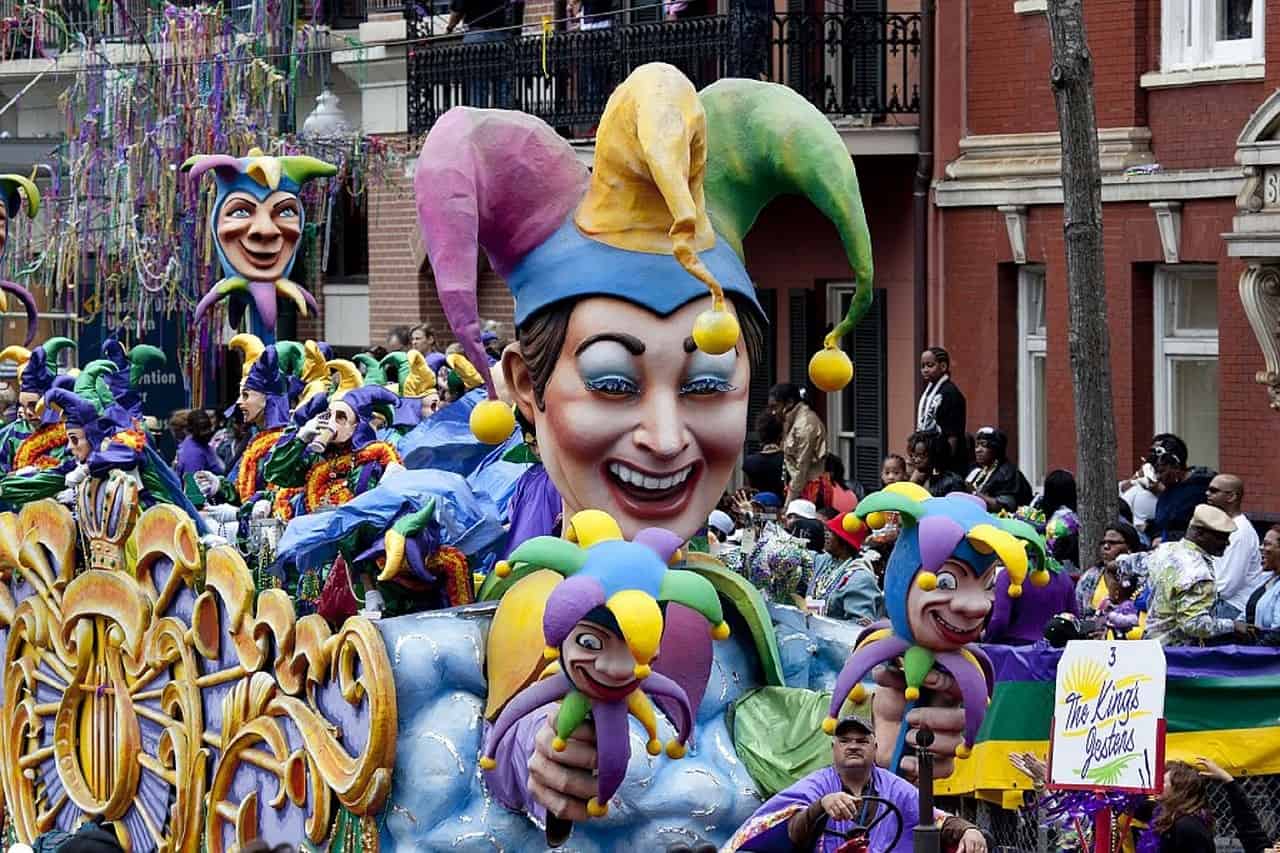
Mardi Gras isn’t just celebrated in New Orleans.
The city is especially famous for it, but it’s actually celebrated across the whole of Louisiana. The festival lasts for two weeks, right up to Shrove Tuesday, the day before Ash Wednesday and the beginning of Lent.
Mardi Gras parades take place every day.
People commonly think that the parades take place on the last day of the festival, but this isn’t actually the case. Parade organizers and participants called krewes, actually hold at least 1 parade per day, depending on the weather. Of course, the biggest and most flamboyant parades take place towards the end of the festival, during its last 5 days.
Mardi Gras parades in New Orleans follow various routes across the city.
Many of them take a route along Bourbon Street, in the French Quarter of New Orleans. However, most major parades follow a route along Saint Charles Avenue and Canal Street, from Uppertown and the Mid-City Districts.
Mardi Gras has its own set of heraldic colors.
Louisiana’s colors are green, gold, and violet, used on flags and streamers for the elected Rex or King of the annual festival. When first used in 1872, the colors of the festival didn’t actually have meaning and were chosen purely for aesthetic reasons. It wasn’t until 1892 that the colors gained meaning. Violet became associated with justice, green with power, and gold with faith. How’s that for colorful Louisiana facts?
People don’t usually wear masks and costumes before Mardi Gras’ climax.
Aside from the krewes who don full Mardi Gras gear the whole time, ordinary people celebrating the festival usually only wear their masks and costumes on the last day of the festival. On this day, it’s also traditional for businesses that prohibit the wearing of masks on their premises to suspend said prohibition in the spirit of the occasion.
Krewes throw out items during the Mardi Gras parades.
Other than wearing masks, it’s also customary for Mardi Gras celebrants to throw beads made from imported glass. However, Lousiana swapped out European glass beads for plastic beads made from China. Eventually, they also adopted metal beads in the 1990s.
Krewes also throw toys like plushies or other dolls for the crowds to catch. Some of these toys even feature LEDs or other simple electronics. In recent years, glass beads have made a comeback, usually ones imported from India.
Mardi Gras celebrations feature more than parades.
Although everyone can participate in Mardi Gras festivities, the biggest celebrations belong to exclusive social clubs. Most of these elite groups hold their own individual parades. In fact, the biggest parades on Mardi Gras are held by Zulu and Rex, sharing their name with their sponsoring clubs.
Each Mardi Gras parade has its own king and queens.
Queens usually have an age of between 18 and 21, must be unmarried, and either in high school or college. The king is an older male, and both get attended to by a court of maids usually comprised of girls aged between 16 and 18.
The king and queen along with their maids present themselves at a Court made up of other participants, traditionally at a local bar, before the parade begins. A rather flashy example of Louisiana facts that show its intricate culture.
Carrying torches is an enduring Mardi Gras tradition.
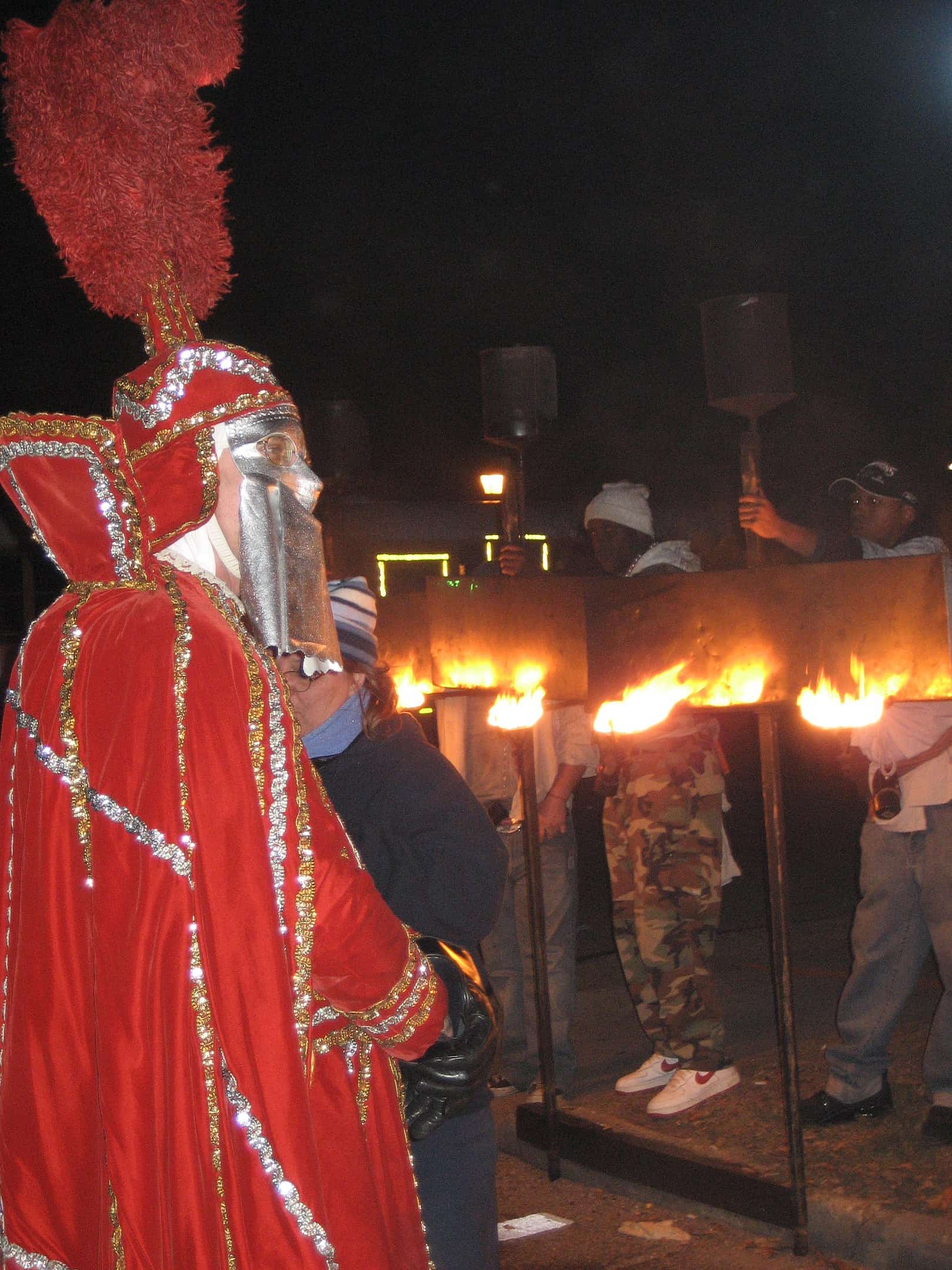
This goes back to before the development of modern electrical lighting. At the time, torches provided large amounts of light for parades at night, and quickly became an iconic part of the celebration.
Even long after the development of electrical lighting, torches stayed a part of the Mardi Gras celebration. More than that, torch bearers are actually something of a family tradition, with their children following in their footsteps.
Was this page helpful?
Our commitment to delivering trustworthy and engaging content is at the heart of what we do. Each fact on our site is contributed by real users like you, bringing a wealth of diverse insights and information. To ensure the highest standards of accuracy and reliability, our dedicated editors meticulously review each submission. This process guarantees that the facts we share are not only fascinating but also credible. Trust in our commitment to quality and authenticity as you explore and learn with us.
